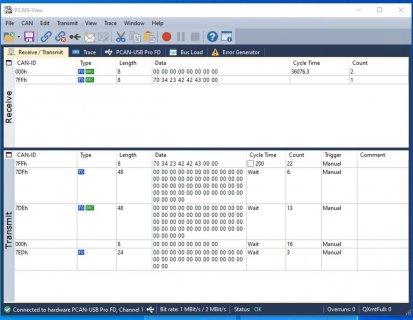Good afternoon,
This is my first post after having followed this great forum for a while. I am reaching out because I would need some help with my new project: I'd like to understand the communication of an avionics device that uses the CAN bus to communicate to a bunch of other avionics devices on an avionics (CAN) bus in order to control it with the help of a Teensy 4.1. So far I've been able to get my T4.1 running some examples enabled by the FlexCAN_T4 library. I can see the output of the avionics device in the log via my serial monitor and I can make some sense out of it.
To get a more comprehensive understanding of the protocol and messages I'd like to use a CAN sniffing tool under Windows now. This tool interfaces CAN sniffers which use the Lawicel CAN/Serial protocol via USB. And here is my question: Is there a piece of software ready to run on a T4.1 that provides this protocol? I am aware of mjs513's CAN Bus monitor (https://github.com/mjs513/Teensy_Canbus_Monitor_IFCT) but it seems to work on a T3.x only.
Thanks very much in advance for your help!
This is my first post after having followed this great forum for a while. I am reaching out because I would need some help with my new project: I'd like to understand the communication of an avionics device that uses the CAN bus to communicate to a bunch of other avionics devices on an avionics (CAN) bus in order to control it with the help of a Teensy 4.1. So far I've been able to get my T4.1 running some examples enabled by the FlexCAN_T4 library. I can see the output of the avionics device in the log via my serial monitor and I can make some sense out of it.
To get a more comprehensive understanding of the protocol and messages I'd like to use a CAN sniffing tool under Windows now. This tool interfaces CAN sniffers which use the Lawicel CAN/Serial protocol via USB. And here is my question: Is there a piece of software ready to run on a T4.1 that provides this protocol? I am aware of mjs513's CAN Bus monitor (https://github.com/mjs513/Teensy_Canbus_Monitor_IFCT) but it seems to work on a T3.x only.
Thanks very much in advance for your help!


